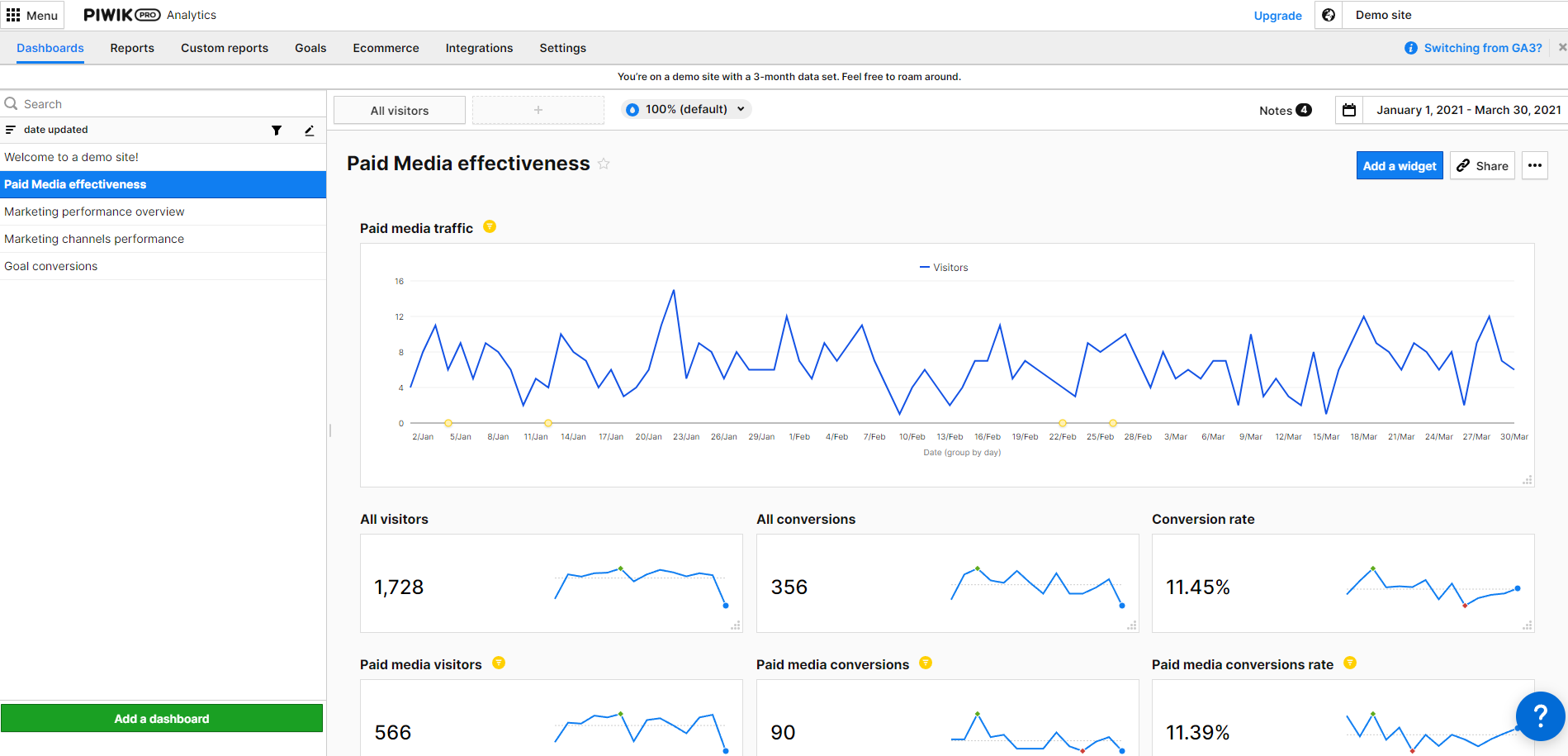
Google Analytics is everywhere. Projects that do not use one of Google's analytics tools are the exception, and often have very specific justifications for not using it.
This article was first published on March 22, 2022, and was updated on January 9, 2024.
Here in Norway, Google Analytics has been the de facto standard analytics tool for over 20 years, but after the transition to GA4, there are three major reasons to consider other alternatives:
1. Privacy risks
After the Schrems II-ruling stated that all transfers of unencrypted personal data from the EU to the US are illegal, many started to seriously look for alternatives to the service we have used for the past few decades to collect and analyze customer information.
In July 2023, it was determined that Google Analytics 4 (GA4) is legal in the EU/EEA as long as certain guidelines are followed, so the argument for privacy risk is now less significant than it was before.
However, in principle, it is still safest for privacy to process customer data oneself without relying on US servers. Although analytics tools are largely Software-as-a-Service (SaaS), meaning services operated from an external server, it is actually a natural thing to manage one's own analytics data in the same way one manages their own website: with a server under their own control.
GA4 anonymizes IP addresses by default. This is a change from the older version, Universal Analytics, where IP address anonymization was an option that had to be activated. In GA4, IP addresses are masked, which means they lose accuracy and only provide regional data (e.g., state or territory) instead of city-level data. Even though IP addresses are anonymized, there are still concerns about their transmission and potential legal uncertainties they may create.
Google Analytics 4 still uses cookies as the default method for collecting data, and cookies can be used to link user data to the user's Google account, which is problematic for privacy. However, GA4 can also be used without cookies, which will lead Google to use modeling to collect user data.
2. User interface and functionality
A lot has been said about how GA4 feels like a significant downgrade from GA3. Some examples:
-
Annotations and simple visualization options have been removed.
- Data searching functionality has been reduced, such as the inability to use regex searches.
- Many useful standard reports are gone, and you have to use the new Explorations-section to make your own reports, which has a steep learning curve.
- Changes to existing Audiences are not possible; if you make a mistake, you have to start from scratch.
- Editing reports to use basic dimensions like Landing Page in a Traffic report is not straightforward.
GA4, therefore, feels like a stripped-down version of GA3 while also becoming more difficult to use! That's quite an accomplishment. GA4 is still under development, and it would have been fine if users were not forced to migrate to the new solution. Many marketers are struggling to achieve even simple tasks, such as connecting GA4 Audiences to Google Ads.
It appears that Google, by limiting functionality, is trying to push users towards BigQuery, a data warehouse where users have more detailed control over their data. BigQuery offers an API for data storage and queries, where users pay for storage and per query.
3. User support
Documentation of the basic functions is covered on support.google.com, but if you have more advanced questions, you encounter an issue. If you take a look at Google's analytics forums, you quickly notice that no one from Google is there answering questions. As a result, the analytics community has established, among other things, a Slack channel run by volunteers where users can ask questions and share answers.
Having user-driven forums like these is excellent because users themselves have experience using the tool in real-life situations. However, since no one has access to the source code, you often end up guessing or creating workarounds to achieve things that may or may not be possible in simpler ways.
Two alternatives to Google Analytics
Because GA4 is being developed in the way it is, many are looking for something better. There are a whole bunch of alternatives out there, but for us, there are really only two real challengers. We take a look at Matomo and Piwik PRO to see if either of them is a worthy replacement for Google Analytics 4.
Matomo
Even though the name Matomo came to light in 2018, the tool is simply a fork from Piwik, which has been around since 2007. At Frontkom, we actually used Piwik as the default solution in a separate solution for online newspapers that we created in 2013.
The fact that NASA uses Matomo should be a pretty strong argument in itself, but also organizations like Amnesty, and especially the EU commision, are part of this group.
Do we recommend switching to Matomo?
No, even though we did so previously. The reason for the recommendation back then was:
- Most importantly: Extremely granular privacy settings. Regardless of how GDPR evolves in the future, you will be able to comply with the requirements using Matomo.
- The interface and features are quite similar to GA, so the learning curve is not as steep as with some other solutions.
- Matomo has self-hosting.
Other advantages of Matomo
- Used by major players like Sikt, Forbrukertilsynet, the UN, the EU Commission, NASA, and more.
- Has a Tag Manager modeled on Google Tag Manager, which mostly has the same functionality.
- Historical data can be imported from Google Analytics.
- Large Plugin store with many extension possibilities.
- Ready for integration with e-commerce solutions like Woocommerce, Drupal Commerce, and Magento, as well as various other tools. If you use Shopify, however, you may encounter some hurdles.
- The option to have Matomo as a SaaS solution. The servers are located in Germany, which is, of course, under GDPR.
Downsides
So, Matomo has many advantages, but here are the downsides that make the tool fall short of addressing the issues with GA4:
- Awful user interface. Matomo looks like it was made in 2003, and that too without UX designers on the team. Almost every element, including forms and text fields, is awkwardly set up and challenging to use.
- User support is at least as poor as Google's.
- If you want to export data to visualization tools like Looker, you have very limited options. You either have to use a connector like Supermetrics or export via CSV, import the file into Google Sheets, and send it to Looker Studio via a macro. If the reason for switching analysis tools is to avoid Google, this becomes absurd.
- Limited functionality without plugins (which often come with a cost).
Piwik PRO Analytics Suite

Piwik PRO has a clear goal of taking over from Google Analytics as the serious GDPR-compliant alternative. For larger organizations, this can be the right tool as it is highly functional and has good help pages and training programs.
Piwik PRO is very feature-rich and includes its own tool for managing personal data and consent/cookies, as well as a dedicated Tag Manager. It is also used for analysis on larger intranets. Data is stored either on your own server or on servers in Europe, providing full control over your own data.
Do we recommend Piwik PRO?
Yes!
Advantages
- The biggest advantage is the ability to "self-host" like Matomo, addressing privacy concerns. The reason for the quote marks is that you are limited to cloud solutions such as Azure, Orange Cloud, or Elastex. They all have servers in the EU, though.
- Robust privacy settings comparable to Matomo.
- Superior user interface compared to Matomo and, in many aspects, better than GA4.
- Active developer responses in the Piwik PRO community. You can't overestimate the value of the ones familiar with the inner workings of the tool actually answering questions.
- Well-documented with good support and effective training for new users.
- Trusted by major entities such as the EU Commission, various national governments, and commercial giants like Microsoft.
- Integration capability with a wide range of reputable business tools for publishing, analysis, advertising, and data storage.
- Dashboard featuring drag-and-drop functionality, similar to Google's Looker Studio.
- Historical data import feature prevents starting from scratch.
- Initially free, but full utilization incurs licensing costs.
Downsides
- Opaque pricing structure. Here is the familiar "get a quote" approach, but you'll end up paying 300 to 500 Euro per month for the paid version.
- Becomes expensive for more advanced features beyond the basic version.
- No direct method for transferring data from Google Analytics; Piwik recommends using tools like Power BI.
- The complexity of the tool may necessitate some training.
Conclusion
In the battle between GA4, Matomo, and Piwik PRO, Piwik emerges as a clear winner based on the issues that GA4 currently faces.
| Google Analytics 4 | Matomo | Piwik PRO | |
| Selvhosting | No | Yes | Yes |
| Brukergrensesnitt og funksjonalitet | Diceroll 3 | Diceroll 1 | Diceroll 5 |
| Brukerstøtte | Diceroll 0 | Diceroll 1 | Diceroll4 |
We help you choose and implement your tool
For most companies, it has not been necessary until now to consider alternative web analytics tools other than Google Analytics. That time is over. There are several good alternatives to Google Analytics, but they all have strengths and weaknesses.
Which analytics tool suits your needs depends on the insights you require to make informed decisions, use cases, and the cost-benefit ratio.
Feel free to contact me or someone else at Frontkom via the form below for more information on this topic or any of the other services we offer.
Usikker på valget? Ta kontakt

Henrik Akselsen
Henrik is the Head of Insights and Analysis in Frontkom. He has 15+ years of experience as a CMS consultant, developer and web analyst. Henrik is almost obsessed in finding out what works on web and how to get there with content strategy and data analysis tools.



.jpg?width=308&height=173&name=Featured%20image_%201100x550px%20(8).jpg)
